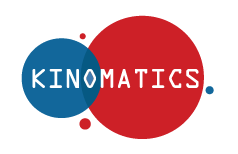Tools
The management and processing of a large dataset such as the one proposed by The Kinomatics Project is beyond the capacity of preceding technological approaches based on local, specialized data facilities. Instead, projects such as Kinomatics require innovative solutions able to simultaneously address the needs imposed by multidisciplinary collaborations and by the new data-intensive analysis. These needs are characterised by the well known three V’s: (i) Volume – data dimension in terms of bytes is challenging, (ii) Velocity – data collection, processing and consumption is demanding in terms of the speed of provision, and (iii) Variety – data heterogeneity, in terms of data types and data sources requiring integration, is high. A fourth V describes our exploratory approach: Visualisation.
Cartograms, Animations, Space-time prisms and other innovative data visualisations such as interactive network diagrams will be explored as a means for displaying, assessing and explaining relationships between venues, patrons, and their environments.
The tools that we are using to assist us in representing our data will be progressively described on this page.
ArcGIS
ArcGIS is a powerful proprietary software Geographic Information System (GIS) package for spatial analysis and display. Analysis is the key here and it really can’t be matched for range and advanced control over spatial data analysis. As it is a large and advanced software package it takes quite a while to get used to. A background in spatial sciences is recommended to fully utilise the tools available. It is however a great tool to learn as the mapping and basic spatial analysis and query capabilities are relatively easy to pick up.
Oriana
The circular graphs were produced using software called “Oriana Version 4”. Oriana is a circular statistics package developed by Kovach Computing Services in the UK. The package has been developed for Windows as is available from http://www.kovcomp.co.uk/oriana/. Oriana enables analyses of circular data, that is data that is measured in degrees, time of day, month of year, day of year etc. and is an ideal mechanism for comparing screening data from different parts of the world throughout the year.
Tableau
Tableau is based on breakthrough technology from Stanford University that lets you drag & drop to analyze data. Tableau is brilliant for exploring your data, seeing what patterns there are and what relationships exist, and making beautiful data visualisations. This is a very efficient way of taking raw data and creating a visualisation and it is just as simple to switch between different types of visualisations or to change what type of information you wish to show. It can be used simply and also in a more complex manner for statistics as the latest version can be linked with R. They have a free trial which is good to test out.
TileMill
TileMill is a free and open source cartography program. It is easy to install and relatively easy to use. The main drawback is that everything is created and controlled using code. This can be very challenging for those that aren’t used to working in this way but once you are over the first learning hurdle the package has a lot of potential. For those that want to play around with the look of their map then this might not be the best choice as the user can’t simply click on different colours, line styles, or point symbols from a menu, it all has to be coded. It is however compatible with many different data sources including ESRI Shapefile, KML, GeoJSON, GeoTIFF, PostGIS, CSV, and SQLite which makes it very flexible. It is also very web friendly through the extended use of Mapbox for professional and interactive displays.
